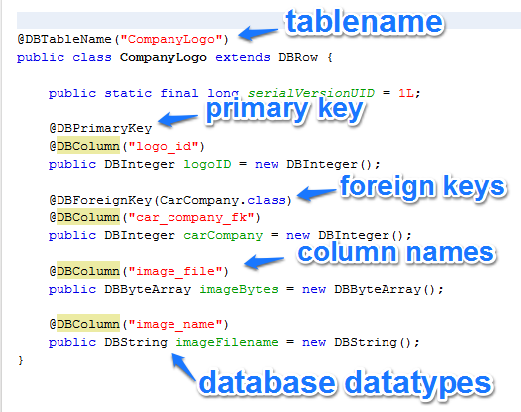Create and Improve Your Data Model
DBRow captures the concept of a row in a database table, and the properties of the table
 You use DBRow by creating a subclass that contains annotations and fields that capture the names, type, and relationships of the table.
You use DBRow by creating a subclass that contains annotations and fields that capture the names, type, and relationships of the table.
This architecture allows Query By Example and dynamic query creation
Infinitely many queries are available to you automatically. There is never a need to pre-define any SQL queries and you never write SQL
DBvolution is designed so DBRow subclasses are easy to write but you can use DBTableClassGenerator to generate the classes automatically
To start querying create a blank DBRow subclass using the default constructor
CompanyLogo logoExample = new CompanyLogo();
The classes of the field allow you set the permitted values of the fields to constrain your query. DBInteger, DBString, and DBByteArray are examples of QueryableDatatype which is key to defining query criteria
logoExample.carCompany.permittedValues(ford.uidCarCompany);
Finally get the list of relevant rows using DBDatabase's get(DBRow) method
List<CompanyLogo> foundLogos = database.get(logoExample);
Now you have a collection of all the database objects that you need available to reference, copy, update, and delete them as required. DBDatabase provides a convenient print method to view the results
database.print(foundLogos);
logoID:2, carCompany:2, imageBytes:/*BINARY DATA*/, imageFilename:ford_logo.jpg
Here's what all that code looks like in the IDE:

Simple Solution to Complex Foreign Keys
Sometimes a DBRow will connect to another DBRow with 2 or more foreign key fields. For instance an Employee record might reference a manager and a mentor (also a manager) both of which are in the same table. This can have strange results but DBvolution allows you to subclass the referenced class to create a specialized foreign key using public class Mentor extends Manager{} and @DBForeignKey(Mentor.class)that will only be linked when you add the Mentor class to the query
Predefined Subsets Of Tables
Some tables are usually divided into a small number of subsets, lookup tables are a good example. You can build these subsets into your data model using a subclass and an initialization clause:
public class Employee extends DBRow
{
DBString department = new DBString();
...
}
public class Accountants extends Employee
{
{
department.permittedValues("ACCOUNTS");
}
}
When you want DB to be easier and faster...
Get DBvolution from GitHub or Maven
Contact us now for details +64 27 444 5201